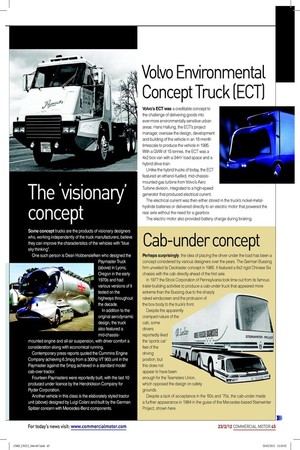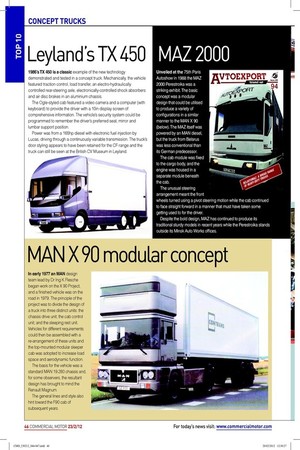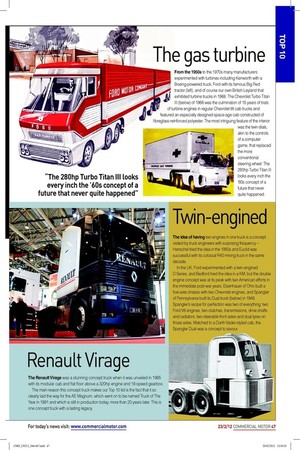TOP 10
Page 37

Page 38

Page 39

Page 40

If you've noticed an error in this article please click here to report it so we can fix it.
CONCEPT TRUCKS
Original ideals that led the way
Thinking outside
the box
CM gives you the Lowdown on the top 10 concept trucks of aLL time
Words: Richard Stanier Concept trucks have been with the industry for years, with manufacturers and designers trying out new ideas to address speciic problems or test new technology and styling on vehicle buyers and drivers. In recent years, such concepts frequently appear as the digitallycreated products of design students, but here we look back at some memorable concept trucks that made it on to the road, and either went into full-scale production or just into the industry’s heart.
Bedford TM Long Haul
The TM Long Haul was a product of the Bedford Design Studios and was exhibited in 1978 as a showcase for the company’s thinking on aerodynamic styling and driver amenity. Over the years, many truck makers have displayed production chassis with significantly improved styling or power under the concept banner.
Interior details
Bedford’s attempt was to take a standard TM 4200 6x4 tractor and significantly revise the external appearance with an adjustable air deflector, below-bumper air dam, chassis fairings, rear cab deflectors and a raised roof line, all of which were newish developments in the 1970s.
Attention was paid to the interior, too, with the cab incorporating air conditioning, a fold-away swivel seat, fridge freezer, cold box, microwave, and hot and cold running water.
The TM Long Haul was a good example of a mass producer of fleet trucks producing something a little bit special.
The ‘visionary’ concept
Some concept trucks are the products of visionary designers who, working independently of the truck manufacturers, believe they can improve the characteristics of the vehicles with “blue sky thinking”.
One such person is Dean Hobbensiefken who designed the Paymaster Truck (above) in Lyons, Oregon in the early 1970s and had various versions of it tested on the highways throughout the decade.
In addition to the original aerodynamic design, the truck also featured a mid-chassismounted engine and all-air suspension, with driver comfort a consideration along with economical running.
Contemporary press reports quoted the Cummins Engine Company achieving 6.3mpg from a 300hp VT 903 unit in the Paymaster against the 5mpg achieved in a standard model cab-over tractor.
Fourteen Paymasters were reportedly built, with the last 10 produced under licence by the Hendrickson Company for Ryder Corporation.
Another vehicle in this class is the elaborately styled tractor unit (above) designed by Luigi Colani and built by the German Spitzer concern with Mercedes-Benz components.
Volvo Environmental Concept Truck (ECT)
Volvo’s ECT was a creditable concept to the challenge of delivering goods into ever-more environmentally sensitive urban areas. Hans Hallung, the ECT’s project manager, oversaw the design, development and building of the vehicle in an 18-month timescale to produce the vehicle in 1995.
With a GVW of 15 tonnes, the ECT was a
4x2 box van with a 34m3 load space and a
hybrid drive train.
Unlike the hybrid trucks of today, the ECT featured an ethanol-fuelled, mid-chassis mounted gas turbine from Volvo’s Aero Turbine division, integrated to a high-speed generator that produced electrical current.
The electrical current was then either stored in the truck’s nickel-metal hydride batteries or delivered directly to an electric motor that powered the rear axle without the need for a gearbox.
The electric motor also provided battery charge during braking.
Cab-under concept
Perhaps surprisingly, the idea of placing the driver under the load has been a
concept considered by various designers over the years. The German Bussing firm unveiled its Decklaster concept in 1965. It featured a 6x2 rigid Chinese Six chassis with the cab directly ahead of the first axle.
In 1977 the Strick Corporation of Pennsylvania took time out from its famous trailer-building activities to produce a cab-under truck that appeared more extreme than the Bussing due to the sharply raked windscreen and the protrusion of the box body to the truck’s front.
Despite the apparently cramped nature of the cab, some drivers reportedly liked the ‘sports car’ feel of the driving position, but this does not appear to have been enough for the Teamsters Union, which opposed the design on safety grounds.
Despite a lack of acceptance in the ’60s and ’70s, the cab-under made a further appearance in 1984 in the guise of the Mercedes-based Steinwinter Project, shown here.
Leyland’s TX 450
1986’s TX 450 is a classic example of the new technology demonstrated and tested in a concept truck. Mechanically, the vehicle featured traction control, load transfer, an electro-hydraulically controlled rear-steering axle, electronically-controlled shock absorbers and air disc brakes in an aluminium chassis.
The Ogle-styled cab featured a video camera and a computer (with keyboard) to provide the driver with a 10in display screen of comprehensive information. The vehicle’s security system could be programmed to remember the driver’s preferred seat, mirror and lumbar support position.
Power was from a 165hp diesel with electronic fuel injection by Lucas, driving through a continuously variable transmission. The truck’s door styling appears to have been retained for the CF range and the truck can still be seen at the British CV Museum in Leyland.
MAZ 2000
Unveiled at the 75th Paris Autoshow in 1988 the MAZ 2000 Perestroika was a striking exhibit. The basic concept was a modular design that could be utilised to produce a variety of configurations in a similar manner to the MAN X 90 (below). The MAZ itself was powered by an MAN diesel, but the truck from Belarus was less conventional than its German predecessor.
The cab module was fixed to the cargo body, and the engine was housed in a separate module beneath the cab.
The unusual steering arrangement meant the front wheels turned using a pivot steering motion while the cab continued to face straight forward in a manner that must have taken some getting used to for the driver.
Despite the bold design, MAZ has continued to produce its traditional sturdy models in recent years while the Perestroika stands outside its Minsk Auto Works offices.
MAN X 90 modular concept
In early 1977 an MAN design team lead by Dr Ing K Flesche began work on the X 90 Project, and a finished vehicle was on the road in 1979. The principle of the project was to divide the design of a truck into three distinct units: the chassis drive unit; the cab control unit; and the sleeping rest unit. Vehicles for different requirements could then be assembled with a re-arrangement of these units and the top-mounted modular sleeper cab was adopted to increase load space and aerodynamic function.
The basis for the vehicle was a standard MAN 19.280 chassis and, for some observers, the resultant design has brought to mind the Renault Magnum.
The general lines and style also hint toward the F90 cab of subsequent years.
The gas turbine
From the 1950s to the 1970s many manufacturers experimented with turbines including Kenworth with a Boeing-powered truck, Ford with its famous Big Red tractor (left), and of course our own British Leyland that exhibited turbine trucks in 1968. The Chevrolet Turbo Titan III (below) of 1966 was the culmination of 15 years of trials of turbine engines in regular Chevrolet tilt cab trucks and featured an especially designed space-age cab constructed of fibreglass-reinforced polyester. The most intriguing feature of the interior was the twin dials, akin to the controls of a computer game, that replaced the more conventional steering wheel. The 280hp Turbo Titan III looks every inch the ’60s concept of a future that never quite happened.
Twin-engined
The idea of having two engines in one truck is a concept visited by truck engineers with surprising frequency – Henschel tried the idea in the 1950s and Euclid was successful with its colossal R40 mining truck in the same decade.
In the UK, Ford experimented with a twin-engined D Series, and Bedford tried the idea in a KM, but the double engine concept was at its peak with two American efforts in the immediate post-war years. Eisenhauer of Ohio built a five-axle chassis with two Chevrolet engines, and Spangler of Pennsylvania built its Dual truck (below) in 1948. Spangler’s recipe for perfection was two of everything: two Ford V8 engines, two clutches, transmissions, drive shafts and radiators, two steerable front axles and dual tyres on those axles. Matched to a Darth Vader-styled cab, the Spangler Dual was a concept to savour.
Renault Virage
The Renault Virage was a stunning concept truck when it was unveiled in 1985 with its modular cab and flat floor above a 320hp engine and 18-speed gearbox.
The main reason this concept truck makes our Top 10 list is the fact that it so clearly laid the way for the AE Magnum, which went on to be named Truck of The Year in 1991 and which is still in production today, more than 20 years later. This is one concept truck with a lasting legacy.












































